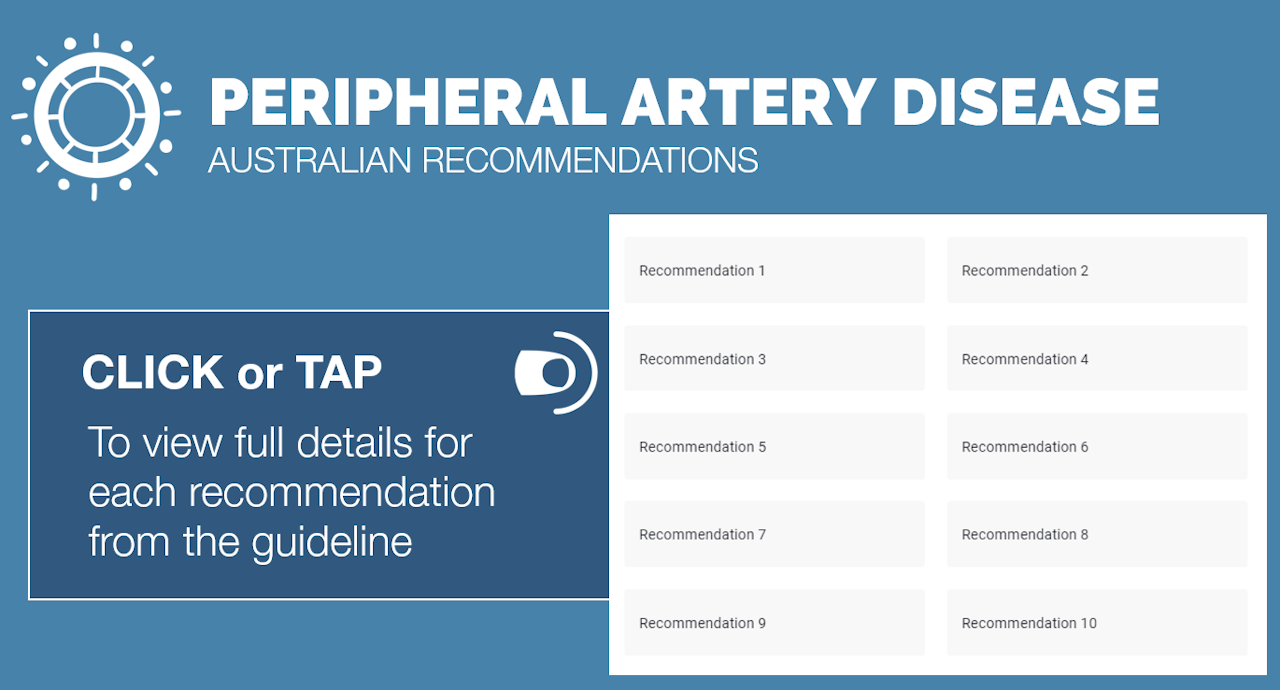

PAD RECOMMENDATION LIST | |
RECOMMENDATION 1 | |
Examine the feet of all patients with diabetes annually for the presence of peripheral artery disease (PAD) even in the absence of foot ulceration. At a minimum, this should include taking a relevant history and palpating foot pulses. (Strength of the recommendation: strong; quality of the evidence: low) | |
RECOMMENDATION 2 | |
Clinically examine (by relevant history and palpation of foot pulses) all patients with diabetes and foot ulceration for the presence of PAD. (Strong; low) | |
RECOMMENDATION 3 | |
As clinical examination does not reliably exclude PAD in most persons with diabetes and a foot ulcer, evaluate pedal Doppler arterial waveforms in combination with ankle systolic pressure and systolic ankle brachial index (ABI) or toe systolic pressure and toe brachial index (TBI) measurement. No single modality has been shown to be optimal, and there is no definite threshold value above which PAD can reliably be excluded. However, PAD is a less likely diagnosis in the presence of ABI, 0.9-1.3; TBI, ≥ 0.75; and triphasic pedal Doppler waveforms. (Strong; low) | |
RECOMMENDATION 4 | |
Perform at least one of the following bedside tests in a patient with a diabetes-related foot ulcer and PAD, any of which increases the pretest probability of healing by at least 25%: a skin perfusion pressure of ≥40 mmHg, a toe pressure of ≥30 mmHg, or a transcutaneous oxygen pressure (TcPO₂) of ≥25 mmHg. (Strong; moderate) | |
RECOMMENDATION 5 | |
Use the Wound, Ischaemia, and foot Infection (WIfI) classification system as a means to stratify amputation risk and revascularisation benefit in a patient with a diabetes-related foot ulcer and PAD. (Strong; moderate)comparisons between institutions on the outcomes of patients with diabetes and an ulcer of the foot (strong; high) | |
RECOMMENDATION 6 | |
Always consider urgent vascular imaging, and revascularisation, in a patient with a diabetes-related foot ulcer and an ankle pressure of<50 mmHg, ABI of <0.5, a toe pressure of <30 mmHg, or a TcPO₂ of <25 mmHg. (Strong; low) | |
RECOMMENDATION 7 | |
Always consider vascular imaging in patients with a diabetes-related foot ulcer, irrespective of the results of bedside tests, when the ulcer is not healing within 4 to 6 weeks despite good standard of care. (Strong; low) | |
RECOMMENDATION 8 | |
Always consider revascularisation in a patient with a diabetes-related foot ulcer and PAD, irrespective of the results of bedside tests, when the ulcer is not healing within 4 to 6 weeks despite optimal management. (Strong; low) | |
RECOMMENDATION 9 | |
Do not assume diabetes-related microangiopathy, when present, is the cause of poor healing in patients with a diabetes-related foot ulcer; therefore, always consider other possibilities for poor healing. (Strong; low) | |
RECOMMENDATION 10 | |
Use any of the following modalities to obtain anatomical information when considering revascularising a patient’s lower extremity: colour duplex ultrasound, computed tomographic angiography, magnetic resonance angiography, or intra-arterial digital subtraction angiography. Evaluate the entire lower extremity arterial circulation with detailed visualisation of below-the-knee and pedal arteries, in an anteroposterior and lateral plane. (Strong; low) | |
RECOMMENDATION 11 | |
When performing revascularisation in a patient with a diabetes-related foot ulcer, aim to restore direct blood flow to at least one of the foot arteries, preferably the artery that supplies the anatomical region of the ulcer. After the procedure, evaluate its effectiveness with an objective measurement of perfusion. (Strong; low) | |
RECOMMENDATION 12 | |
As evidence is inadequate to establish whether an endovascular, open, or hybrid revascularisation technique is superior, make decisions based on individual factors, such as morphological distribution of PAD, availability of autogenous vein, patient co-morbidities, and local expertise. (Strong; low) | |
RECOMMENDATION 13 | |
Any centre treating patients with a diabetes-related foot ulcer should have expertise in, and/or rapid access to facilities necessary to diagnose and treat, PAD, including both endovascular techniques and bypass surgery. (Strong; low) | |
RECOMMENDATION 14 | |
Ensure that after a revascularisation procedure in a patient with a diabetes-related foot ulcer, the patient is treated by a multidisciplinary team as part of a comprehensive care plan. (Strong; low) | |
RECOMMENDATION 15 | |
Urgently assess and treat patients with signs or symptoms of PAD and a diabetes-related foot infection, as they are at particularly high risk for major limb amputation. (Strong; moderate) | |
RECOMMENDATION 16 | |
Avoid revascularisation in patients in whom, from the patient’s perspective, the risk-benefit ratio for the probability of success of the procedure is unfavourable. (Strong; low) | |
RECOMMENDATION 17 | |
Provide intensive cardiovascular risk management for any patient with diabetes and an ischaemic foot ulcer, including support for cessation of smoking, treatment of hypertension, control of glycaemia, and treatment with a statin drug as well as low-dose clopidogrel or aspirin. (Strong; low) |
